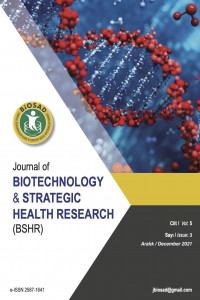Öz
SARS-CoV-2’nin neden olduğu COVID-19’da değişim ve/veya harabiyet tablolarına her geçen gün yenileri eklenmektedir. Birçok hücreyi enfekte edebilen bu virüsün ter bezi Krt7+ salgı lümen hücrelerini de kolayca enfekte edebildiği gösterilmiştir. Uçucu organik bileşikler ise birçok hastalık için biyomarker olup çeşitli hastalık ve sendromlarla ilişkilendirilmiştir. SARS-CoV-2’nin ter salgısını değiştirebileceği ve yarattığı tahribatlarla uçucu organik bileşikler ortaya çıkarabileceği gösterilmiştir. Bu yazımızda SARS-CoV-2 ile enfekte olan hastada, enfeksiyon esnasında gelişen ter kokusu değişimi sunulmuştur.
Anahtar Kelimeler
Kaynakça
- Liu J, Li Y, Liu L, Hu X, Wang X, Hu H, et al. Infection of human sweat glands by SARS-CoV-2. Cell Discov. 2020;6:84.
- Schmidt K, Podmore I. Current Challenges in Volatile Organic Compounds Analysis as Potential Biomarkers of Cancer. J Biomark. 2015;2015:981458.
- Sakr R, Ghsoub C, Rbeiz C, Lattouf V, Riachy R, Haddad C, et al. COVID-19 detection by dogs: from physiology to field application—a review article. Postgraduate Medical Journal. 2021. p. ostgradmedj–2020. doi:10.1136/postgradmedj-2020-139410
- Harker M. Psychological sweating: a systematic review focused on aetiology and cutaneous response. Skin Pharmacol Physiol. 2013;26:92–100.
- Semkova K, Gergovska M, Kazandjieva J, Tsankov N. Hyperhidrosis, bromhidrosis, and chromhidrosis: Fold (intertriginous) dermatoses. Clin Dermatol. 2015;33:483–491.
- Hung R, Lee S, Bennett JW. Fungal volatile organic compounds and their role in ecosystems. Appl Microbiol Biotechnol. 2015;99:3395–3405.
- Amann A, Costello B de L, Miekisch W, Schubert J, Buszewski B, Pleil J, et al. The human volatilome: volatile organic compounds (VOCs) in exhaled breath, skin emanations, urine, feces and saliva. J Breath Res. 2014;8:034001.
- Besa V, Teschler H, Kurth I, Khan AM, Zarogoulidis P, Baumbach JI, et al. Exhaled volatile organic compounds discriminate patients with chronic obstructive pulmonary disease from healthy subjects. Int J Chron Obstruct Pulmon Dis. 2015;10:399–406.
- Lamote K, Janssens E, Schillebeeckx E, Lapperre TS, De Winter BY, van Meerbeeck JP. The scent of COVID-19: viral (semi-)volatiles as fast diagnostic biomarkers? J Breath Res. 2020;14:042001.
- Grandjean D, Sarkis R, Lecoq-Julien C, Benard A, Roger V, Levesque E, et al. Can the detection dog alert on COVID-19 positive persons by sniffing axillary sweat samples? A proof-of-concept study. PLoS One. 2020;15:e0243122.
Öz
New ones are added to the manifestations of change and/or destruction in COVID-19 caused by SARS-CoV-2 every day. It has been shown that this virus, which can infect many cells, can also easily infect sweat gland Krt7+ secretory lumen cells. Volatile organic compounds are biomarkers for many diseases and have been associated with various diseases and syndromes. It has been shown that SARS-CoV-2 can change sweat secretion and produce volatile organic compounds with the damage it causes. In this article, the change in odor of sweat that developed during the infection in a patient infected with SARS-CoV-2 is presented.
Anahtar Kelimeler
Kaynakça
- Liu J, Li Y, Liu L, Hu X, Wang X, Hu H, et al. Infection of human sweat glands by SARS-CoV-2. Cell Discov. 2020;6:84.
- Schmidt K, Podmore I. Current Challenges in Volatile Organic Compounds Analysis as Potential Biomarkers of Cancer. J Biomark. 2015;2015:981458.
- Sakr R, Ghsoub C, Rbeiz C, Lattouf V, Riachy R, Haddad C, et al. COVID-19 detection by dogs: from physiology to field application—a review article. Postgraduate Medical Journal. 2021. p. ostgradmedj–2020. doi:10.1136/postgradmedj-2020-139410
- Harker M. Psychological sweating: a systematic review focused on aetiology and cutaneous response. Skin Pharmacol Physiol. 2013;26:92–100.
- Semkova K, Gergovska M, Kazandjieva J, Tsankov N. Hyperhidrosis, bromhidrosis, and chromhidrosis: Fold (intertriginous) dermatoses. Clin Dermatol. 2015;33:483–491.
- Hung R, Lee S, Bennett JW. Fungal volatile organic compounds and their role in ecosystems. Appl Microbiol Biotechnol. 2015;99:3395–3405.
- Amann A, Costello B de L, Miekisch W, Schubert J, Buszewski B, Pleil J, et al. The human volatilome: volatile organic compounds (VOCs) in exhaled breath, skin emanations, urine, feces and saliva. J Breath Res. 2014;8:034001.
- Besa V, Teschler H, Kurth I, Khan AM, Zarogoulidis P, Baumbach JI, et al. Exhaled volatile organic compounds discriminate patients with chronic obstructive pulmonary disease from healthy subjects. Int J Chron Obstruct Pulmon Dis. 2015;10:399–406.
- Lamote K, Janssens E, Schillebeeckx E, Lapperre TS, De Winter BY, van Meerbeeck JP. The scent of COVID-19: viral (semi-)volatiles as fast diagnostic biomarkers? J Breath Res. 2020;14:042001.
- Grandjean D, Sarkis R, Lecoq-Julien C, Benard A, Roger V, Levesque E, et al. Can the detection dog alert on COVID-19 positive persons by sniffing axillary sweat samples? A proof-of-concept study. PLoS One. 2020;15:e0243122.
Ayrıntılar
| Birincil Dil | Türkçe |
|---|---|
| Konular | Bulaşıcı Hastalıklar |
| Bölüm | Olgu Sunumu |
| Yazarlar | |
| Yayımlanma Tarihi | 31 Aralık 2021 |
| Kabul Tarihi | 8 Kasım 2021 |
| Yayımlandığı Sayı | Yıl 2021 Cilt: 5 Sayı: 3 |
Dergimiz Uluslararası hakemli bir dergi olup TÜRKİYE ATIF DİZİNİ, TürkMedline, CrossREF, ASOS index, Google Scholar, JournalTOCs, Eurasian Scientific Journal Index(ESJI), SOBIAD ve ISIindexing dizinlerinde taranmaktadır. TR Dizin(ULAKBİM), SCOPUS, DOAJ için başvurularımızın sonuçlanması beklenmektedir.


